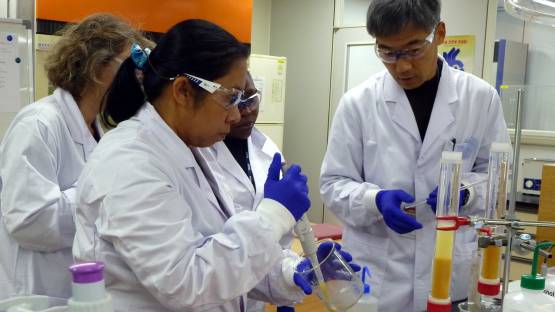Milk and milk products are principal pathways for radiation contamination in the event of a radiological emergency. With the support from the IAEA, a state-of-the-art method has been developed that could quickly and precisely check for the presence of radionuclides in dairy food products.
Twelve scientists, representing laboratories from Canada, France, Greece, Indonesia, Ireland, Malaysia, Pakistan, South Africa, Sri Lanka, Thailand, Turkey and Ukraine, gathered for a week in Daejeon, Republic of Korea to gain hands-on experience in such methods. The venue was an ALMERA practical training course on the rapid determination of ‘radioactive strontium’ in milk and the methods and procedures involved in its assessment.
ALMERA stands for Analytical Laboratories for the Measurement of Environmental Radioactivity and is an acronym for a worldwide network of analytical laboratories capable of providing reliable and timely determination of radionuclides in samples used for both routine and emergency environmental monitoring. The scientists attending the practical training course all worked in laboratories belonging to the ALMERA network.
Held in Daejeon, Republic of Korea from 3 to 7 November 2014, the ALMERA course provided the scientists with practical knowledge in the state-of-the-art method for quick and precise assessment of radionuclides in dairy food products in the event of a radiological emergency. It was organized by the IAEA Environment Laboratories, in cooperation with the Korea Institute of Nuclear Safety (KINS).
Mr. David Osborn, Director of the IAEA Environment Laboratories, explained that the advanced nuclear analytical methods that laboratories use to acquire swift results on radionuclides content are of vital importance.
“In case of a radiological emergency situation, radioactive strontium may be released to the environment and may present human health issues due to its potential incorporation into the calcium pool of the human body through the principal pathway: soil to plant to cow’s milk to humans,“ Mr. Osborn said. “Therefore, in emergency situations, the rapid analysis of radioactive strontium in milk is essential to protect humans from radiation exposure due to intake of contaminated milk.”
The training course included a half-day technical visit to selected KINS facilities, which provided an opportunity for the participants to learn about various nuclear applications. KINS is an IAEA collaborating centre for analytical method development and is the ALMERA regional coordinator for the Asia-Pacific region.
During the course, the participants practised the radioanalytical method in a radiochemical laboratory and were taught specific data analysis techniques for the calculation of the measurement results and their associated uncertainties. Experts from KINS and the IAEA guided the scientists on the key components of the analytical quality work that had to be implemented to reach a conclusive result.
This unique nuclear assessment tool was developed through the cooperative effort amongst ALMERA laboratories. To test the reliability of this innovative laboratory method, a large number of ALMERA laboratories participated to validate the procedure and ensure its reliability. This, in turn, contributed to its wider application and facilitated the harmonization of methods among environmental radioanalytical laboratories.
Since 2004, the IAEA has included within its ALMERA activities the development and validation of a set of procedures for the determination of radionuclides in environmental samples, both for routine and emergency environmental monitoring. These validated procedures cover the measurement of a large number of radionuclides from natural and anthropogenic origin in the different environmental compartments, including soil, water, air aerosols and unprocessed food products.
David Osborn further added that this practical training course, as well as the one hosted by the Argonne National Laboratory in the USA in March 2014, enabled ALMERA laboratories personnel to be trained directly in the laboratory, leading to additional capacity building for routine environmental monitoring and emergency response preparedness.
It is planned that this course will be repeated due to the high demand for such practical training course and to enhance laboratories good practices in the field of nuclear science and technology.
Background:
The ALMERA network currently consists of 149 laboratories in 84 Member States and is coordinated by the IAEA Environment Laboratories. The main network activities relate to the organization of proficiency tests and inter-laboratory comparison exercises, the development and validation of analytical procedures for the measurement of environmental radioactivity, and the organization of training courses and workshops. The goals of participation in the network activities are the demonstration of the technical competence of the ALMERA laboratories, the wider application of recommended validated methods and methodological harmonization leading to enhanced worldwide comparability of environmental radioactivity measurement results, and the development of analytical capabilities of the personnel.


